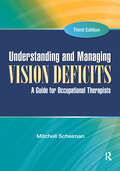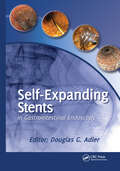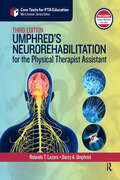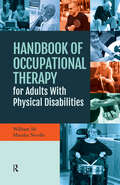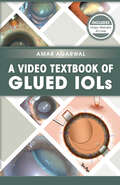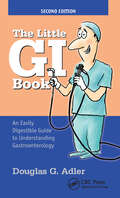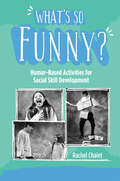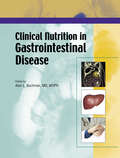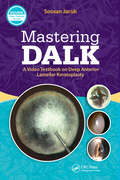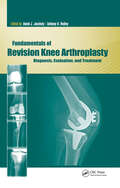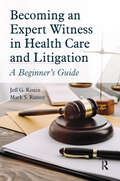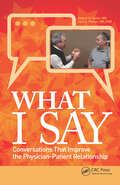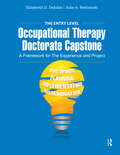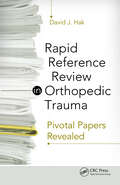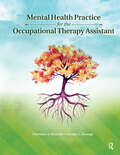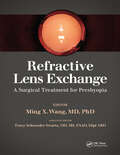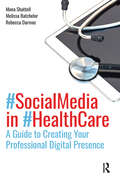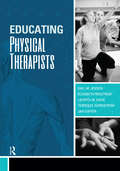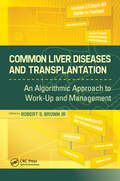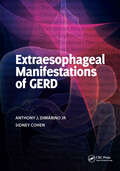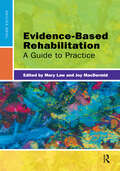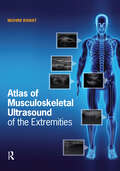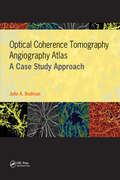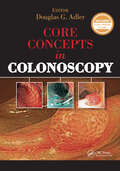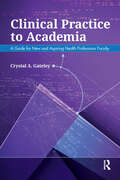- Table View
- List View
Understanding and Managing Vision Deficits: A Guide for Occupational Therapists
by Mitchell ScheimanThe Third Edition of Understanding and Managing Vision Deficits is the go-to resource that will enable occupational therapists to develop a comprehensive understanding of vision, appreciate the various effects vision problems can have on the practice of occupational therapy, and to more effectively manage patients with vision disorders.Understanding and Managing Vision Deficits: A Guide for Occupational Therapists, Third Edition is a unique collaboration from occupational therapists, optometrists, and low vision rehabilitation specialists.Dr. Mitchell Scheiman presents a unique Three Component Model of Vision that includes: Visual integrity: Includes visual acuity (clarity), the optics of the eye, and eye health Visual efficiency skills: Includes focusing, eye teaming, and eye movements Visual information processing skills: Includes the ability to analyze, interpret and respond to visual information A major emphasis of the new edition is on management of eye movement, visual information processing, visual field, and low vision problems. Therapy suggestions have been expanded and the use of computer software has been incorporated into the therapy.Some Additional Chapter Topics Include: Visual problems associated with learning disorders Visual problems associated with acquired brain injury Management of vision problems for children with special needs Low vision Features of the Third Edition: Updated figures, research, and references Incorporates current American Occupational Therapy Association Practice Framework Glossary of key terms Appendices that include a vision screening report form and low vision supplies and equipment Understanding and Managing Vision Deficits: A Guide for Occupational Therapists, Third Edition will continue to bring the professions of occupational therapy and optometry together and will guide health care professionals to provide the ultimate in patient care.
Self-Expanding Stents in Gastrointestinal Endoscopy
by Douglas AdlerThere is a tremendous interest in information on stents in the world of gastrointestinal endoscopy. Many physicians did not train in an era where these stents were available, but are now being called upon to place them. Self-Expanding Stents in Gastrointestinal Endoscopy looks to provide physicians with the necessary and unique all-in-one resource on stents. Self-Expanding Stents in Gastrointestinal Endoscopy by Dr. Douglas G. Adler covers the use of self-expanding stents. This book will cover the use of all available devices in all clinical contexts, with step-by-step instructions from experts in the field on how to use them and, just as importantly, what not to do when using these devices. Self-Expanding Stents in Gastrointestinal Endoscopy is illustrated with more than 150 color photographs, as well as many tables and diagrams.Benefits and Features:· Soup-to-nuts format covers the use of all devices available on the market in all clinical situations· All chapters authored by recognized experts in the world of stents who have independently published extensive research in gastrointestinal endoscopy· Over 150 color photographs to guide readers from start to finish through all steps of learning about the proceduresSelf-Expanding Stents in Gastrointestinal Endoscopy brings attention to the use of self-expanding stents in benign and malignant diseases, the avoidance and management of complications, and the future of these devices.Self-Expanding Stents in Gastrointestinal Endoscopy is the perfect go-to book for all practicing gastroenterologists, fellows, and general and colorectal surgeons.
Umphred's Neurorehabilitation for the Physical Therapist Assistant (Core Texts for PTA Education)
by Darcy Umphred Rolando LazaroA comprehensive guide to neurological rehabilitation for physical therapist assistants (PTAs), Umphred’s Neurorehabilitation for the Physical Therapist Assistant, Third Edition presents contemporary, evidence-based principles and techniques for examination and intervention for individuals with neurological conditions.Umphred’s Neurorehabilitation for the Physical Therapist Assistant, Third Edition addresses a wide variety of pediatric and adult neurological disorders, including spinal cord injury, brain injury, stroke, Parkinson’s disease, multiple sclerosis, amyotrophic lateral sclerosis, Guillain-Barré syndrome, and more.Drs. Lazaro and Umphred have updated this classic text to reflect current and emerging trends in physical therapy, including: The role of the PTA in neurocritical care The role of the PTA in management of clients with lifelong impairments and activity limitations Technology in neurorehabilitation Also included is a new chapter on functional neuroanatomy, which provides the foundational background for understanding the relationship between the structure and function of the nervous system.The Third Edition also features helpful instructor and student resources. Included with the text are online supplemental materials for faculty use in the classroom.Umphred’s Neurorehabilitation for the Physical Therapist Assistant, Third Edition is the definitive resource for any PTA faculty, student, or clinician interested in the physical therapy management of individuals with neurological conditions.
Handbook of Occupational Therapy for Adults with Physical Disabilities
by William Sit Marsha NevilleHandbook of Occupational Therapy for Adults With Physical Disabilities by Drs. William Sit and Marsha Neville provides quick and essential information for occupational therapists that are new to the adult practice setting. This handbook is primarily organized by body system into six sections: Occupational performance as a whole Central nervous system Peripheral nervous system, cranial nerves, and sensory system Musculoskeletal system Cardiovascular, lymphatic, respiratory, and integumentary systems Endocrine, digestive, urinary, and reproductive system At the beginning of each section, you will find a case study based on clinical experience that embodies the chapter subject. Within each section information is broken down into important aspects of the evaluation process, and then followed by the implications of each system on occupational therapy intervention. Handbook of Occupational Therapy for Adults With Physical Disabilities also includes a summary chart where readers can quickly and easily find the purpose, context, form, cost, and contact information for each assessment.Handbook of Occupational Therapy for Adults With Physical Disabilities is ideal for occupational therapy students, recent graduates, and practitioners who are newly entering an adult physical disability practice setting.
A Video Textbook of Glued IOLs
by Amar AgarwalThe first of its kind to cover the cutting edge technique of glued IOLs in eyes with deficient capsules, A Video Textbook of Glued IOLs combines the practical explanation of written text with the dynamic demonstration of a surgical video website. With this unique combination, the narrated videos are able to demonstrate all the challenging surgical situations, while the textbook will provide more in-depth step-by-step details for each technique.Dr. Amar Agarwal and his contributors are some of the leading pioneers of the glued IOL technique and provide expert advice on all aspects, including complications, predictions of problems, and methods of management.A Video Textbook of Glued IOLs also includes the history of the technique, methods, modifications, combinations, results, and complications, making it the first textbook to collect all the details on glued IOLs and compile them together with over 40 narrated video tutorials into one comprehensive resource hosted on a companion website..A Video Textbook of Glued IOLs offers state-of-the-art instruction from the innovators of the technique themselves and its step-by-step approach makes it simple to understand and easy to reproduce for anterior segment surgeons, junior ophthalmologists, specialists, and post-graduates alike.Some videos include: Subluxated cataract extraction Decentered IOL in the sulcus IOL in the anterior chamber Dislocated IOL in the retina Co-morbid scenarios like microcornea, aniridia, trauma and Coloboma
The Little GI Book: An Easily Digestible Guide to Understanding Gastroenterology
by Douglas AdlerA practical, portable handbook, newly updated with nearly 100 color images and figures, The Little GI Book: An Easily Digestible Guide to Understanding Gastroenterology, Second Edition is an invaluable resource for anyone new to the world of gastroenterology and hepatology. Featuring new information on the latest advancements in gastroenterology and hepatology and written in a friendly, conversational style, The Little GI Book will help readers learn the core concepts of digestive health and disease and absorb important information without a hiccup. Author Dr. Douglas G. Adler provides a comprehensive, soup-to-nuts guide to gastrointestinal anatomy, physiology, disease states, and treatment. With new color images throughout, The Little GI Book guides the reader through the entire gastrointestinal tract, starting at the top with the esophagus, ending at the bottom with the colon and rectum, and covering everything in between: the stomach, small intestine, liver, pancreas, bile ducts, and gallbladder.The Little GI Book is an indispensable pocket guide for residents, students, nurse practitioners, office staff, industry sales force, and anyone who works in the GI industry but isn’t a gastroenterologist.
What's So Funny?: Humor-Based Activities for Social Skill Development
by Rachel ChaietWith ready-to-use lessons and strategies, What’s So Funny?: Humor-Based Activities for Social Skill Development provides readers with tools to help their clients improve their emotional intelligence through humor. Occupational therapists, speech-language pathologists, special educators, behavior therapists, and caregivers will benefit from the implementation of these strategies.What’s So Funny? contains a curriculum of more than 50 activities that emphasize two main ideas. The first is that humor (linguistic or physical) can be taught to many individuals with autism spectrum disorder or other disorders through explicit instruction, exposure to various types of humor, and embracing the individual’s preferred sense of humor. The second is that humorous activities can be used to increase social engagement, which can sometimes be a challenge for those with developmental disabilities.What’s So Funny? includes activities essential for individuals who: Appear to have a very limited concept or basic developmental level of humor Need to improve their understanding of socially appropriate humor Lack understanding of appropriate times to use humor Are nonverbal, have limited expressive communication skills, or use augmentative communication devices Have a difficult time initiating social interactions with their peers With a flexible program that can be used for either small groups or individuals from ages 7 years to adult, What’s So Funny?: Humor-Based Activities for Social Skill Development is a relevant and easy-to-use resource. Discussing a variety of types of humor on different developmental levels, from slapstick to word play, this program improves participants’ abilities to connect and engage with others through the powerful tool of humor.
Clinical Nutrition in Gastrointestinal Disease
by Alan L. BuchmanNutrition has been identified as one of the most neglected, but important aspects of gastroenterology. Clinical Nutrition in Gastrointestinal Disease covers all of the vital aspects of nutrition and serves as the definitive resource on this topic.Dr. Alan Buchman has teamed up with more than 70 world renowned leaders in the field to provide today’s professional specializing in gastrointestinal disease with a practical guide that examines and explains the necessary elements and principles of nutrition. With more than 100 images and 180 tables, Clinical Nutrition in Gastrointestinal Disease contains essential information to optimally and successfully manage pediatric and adult patients.Some Topics Covered Include: Nutritional assessment Nutrition in critical care Nutritional support Management of intestinal failure Obesity Pediatrics Probiotics Nutrient absorption Metabolism Home care Some Gastrointestinal Diseases Covered Include: Inflammatory bowel disease Irritable bowel syndrome Colon cancer Pancreatititis Heptatic failure Celiac sprue Clinical Nutrition in Gastrointestinal Disease delivers the latest information in a comprehensive and well-organized format that is perfect for gastroenterologists, general surgeons, and general internists looking to increase their knowledge of clinical nutrition. The extensive use of images, graphs, and tables compliments the text and makes this one of the most authoritative and thorough books on gastrointestinal disease currently on the market.
Mastering DALK: A Video Textbook on Deep Anterior Lamellar Keratoplasty
by Soosan JacobDue to its instantaneous and visible results for patients both anatomically and visually, anterior lamellar keratoplasty is a field of great interest to corneal surgeons. Newer techniques of DALK, femtosecond assisted DALK, TILK, and more have inherent advantages that make them supersede older techniques of keratoplasty by far.Mastering DALK: A Video Textbook on Deep Anterior Lamellar Keratoplasty by Dr. Soosan Jacob combines the practical explanation of written text with the dynamic demonstration of surgical videos.From pre-operative to post-operative patient management and every surgical technique in between, this unique book and its included video website is a complete education on DALK. This includes the history and basics of lamellar keratoplasty, as well as tutorials on various surgical techniques currently in use, advice for complex situations, and management of possible complications.Each chapter includes high-quality photographs and illustrations and is paired with videos on the accompanying website to demonstrate techniques and provide step-by-step instructions. The surgeries in these videos are performed and narrated by the same team of leading international experts who have also written all of the clinical tips, tricks, and pearls of wisdom throughout the book.Some videos include: Retrieving the Lost Bubble DALK Surgery with Type 1 Big Bubble Groove Peel DALK Femtosecond Laser Assisted DALK SMILE Away a Dermoid Any surgeon looking to add anterior lamellar keratoplasty to their practice will appreciate the digestible nature of Mastering DALK: A Video Textbook on Deep Anterior Lamellar Keratoplasty, which provides both the crucial detail of a book and the irreplaceable value of visual demonstration.
Fundamentals of Revision Knee Arthroplasty: Diagnosis, Evaluation, and Treatment
by David Jacofsky Anthony HedleyFundamentals of Revision Knee Arthroplasty: Diagnosis, Evaluation, and Treatment is a unique and very timely book designed for surgeons who are beginning to more commonly encounter knee revisions in their practice. Unlike many traditional books on revision, Fundamentals of Revision Knee Arthroplasty does not focus on the most difficult and challenging of cases. Rather, Fundamentals of Revision Knee Arthroplasty is intended to guide the surgeon in the evaluation of the failed or painful total joint replacement, review basic tenants and surgical principles of revision arthroplasty, and guide the surgeon in determining whether a given case is one that should be managed or is best referred to a tertiary orthopedic center.Along with their 32 contributors, Dr. David J. Jacofsky and Dr. Anthony K. Hedley provide detailed information inside Fundamentals of Revision Knee Arthroplasty, including appropriate preoperative evaluation, equipment requirements, surgical planning, need for augments and allograft, and surgical techniques.Surgeons will be tackling knee revision surgery more frequently as the number of these cases is exponentially increasing. Fundamentals of Revision Knee Arthroplasty provides a “go-to” resource to turn to for guidance by community arthroplasty surgeons, arthroplasty fellows, and residents.
Becoming an Expert Witness in Health Care and Litigation: A Beginner's Guide
by Mark Ramey Jeff G. KoninA resource for health care professionals in beginning, improving, or successfully marketing a career as an expert witness, Becoming an Expert Witness in Health Care and Litigation: A Beginner’s Guide provides fundamental information on the legal process and practical advice for readers across various fields of medicine and allied health.The book draws on the authors’ experiences as both expert witnesses and litigation experts who have trained hundreds of nurses, physicians, and health care professionals. Covering topics like the fundamentals of litigation and the legal process and trial preparation, Becoming an Expert Witness in Health Care and Litigation explores the basic principles of being an expert witness while offering practical advice that will enable expert witnesses and attorneys to maximize their effectiveness.Topics covered include: Roles and expectations of key players Courtroom presentation Depositions and trials Moral issues Writing for the court Business of expert witnessing Ethical marketing Also included in Becoming an Expert Witness in Health Care and Litigation: Checklists Example expert witness forms like fee structures, engagement letters, and more A comprehensive glossary of industry terms Those looking to break into the field and seasoned expert witnesses alike will find that Becoming an Expert Witness in Health Care and Litigation: A Beginner’s Guide offers valuable insights and guidance.
What I Say: Conversations That Improve the Physician-Patient Relationship
by Jack Parker Robert OsherPhysicians of all disciplines know (or quickly learn the hard way) that effective and compassionate communication is arguably the single most important determinant of patient satisfaction. For cataract surgeons, the words said before, after, and even during the operation are often more important to the patient’s happiness than the objective quality of the surgical result.What I Say: Conversations that Improve the Physician-Patient Relationship is designed to help cataract surgeons to hone their verbal interactions to be as sharp as their surgical skills. Muddled, clumsy, or impromptu explanations diminish the doctor-patient relationship and could prevent patients from receiving the surgery they need or appreciating the results they get. Knowing in advance which words to use in difficult situations is analogous to knowing how to manage a complication before it occurs. The results are inevitably better when a physician has considered every possible outcome instead of attempting to come up with exactly the right solution on the spot. Rather than figure out the right words by trial and error, however, What I Say has recommendations on exactly what to say to build strong and trusting patient relationships. Drs. Robert Osher and Jack Parker have compiled conversational scripts from Dr. Osher’s 40-year career in ophthalmology, as well as contributions from over a dozen international mavens of bedside manner into a strategy guide through even the most difficult patient conversations that inevitably surround cataract surgery.Topics include: Lowering Expectations for Spectacle-Free Vision The Torn Posterior Capsule Postoperative Refractive Surprise The Dropped Nucleus The Unhappy Patient Despite a Good Result Containing examples of conversations with cataract surgery patients where informing and reassuring take top priority, What I Say: Conversations that Improve the Physician-Patient Relationship was created to aid cataract surgeons in their pre-operative, intra-operative, and post-operative interactions with patients. With the advice contained inside, surgeons will be able to motivate patients, calibrate expectations, and diffuse frustrations in every possible scenario.
The Entry Level Occupational Therapy Doctorate Capstone: A Framework for the Experience and Project
by Elizabeth DeIuliis Julie BednarskiThe purpose of The Entry Level Occupational Therapy Doctorate Capstone: A Framework for The Experience and Project is to provide a step-by-step guide for the development, planning, implementation and dissemination of the entry-level occupational therapy doctoral capstone experience and project. The first entry-level occupational therapy doctorate program was established in 1999, but even now there is a scarcity of occupational therapy resources to guide faculty, prepare students and to socialize mentors to the capstone experience and project. The Entry Level Occupational Therapy Doctorate Capstone by Drs. Elizabeth DeIuliis and Julie Bednarski is the first available resource in the field of occupational therapy devoted to the doctoral capstone. Each chapter provides sample resources and useful documents appropriate for use with occupational therapy doctoral students, faculty, capstone coordinators and site mentors.Included Inside: Templates to develop the MOU, individualized doctoral student objectives, and evaluations Examples of how to structure capstone project proposals Learning activities to guide the literature search and development of a problem statement Strategies of how to approach sustainability and program evaluation of the capstone project Recommendations for structure and formatting of the final written document Additional scholarly products derived from the project Other scholarly deliverables including formats for professional presentations and submissible papers The Entry Level Occupational Therapy Doctorate Capstone: A Framework for The Experience and Project will be the first of its kind to serve as a textbook to provide recommendations that will benefit various stakeholders among the capstone team.
Rapid Reference Review in Orthopedic Trauma: Pivotal Papers Revealed
by David HakAre you spending valuable time searching through hundreds of article citations in search of information on a particular injury or treatment?Look to Rapid Reference Review in Orthopedic Trauma: Pivotal Papers Revealed for a quick and succinct way to find the key information and quick facts you need to know instantly.Medical literature continues to expand at an exponential pace and finding the most important information is becoming increasingly difficult. Rapid Reference Review in Orthopedic Trauma: Pivotal Papers Revealed by Dr. David J. Hak offers a simple way to access and review the key points from the most relevant and important published articles.Key references include:• Classic articles• Landmark articles• Up-to-date reviews• Important clinical trialsEach article is formatted to include an article citation, a summation of the abstract, a summary of key points, and author commentary. This enables readers to quickly review key facts from the most important articles and clinical trials in order to effectively plan and guide treatment. Rapid Reference Review in Orthopedic Trauma: Pivotal Papers Revealed is a great literary reference that will prove highly useful to orthopedic residents, fellows, and medical students, as well as practicing and academic orthopedic surgeons.
Mental Health Practice for the Occupational Therapy Assistant
by Christine Manville Jeremy KeoughMental Health Practice for the Occupational Therapy Assistant is a comprehensive text that delineates the role of the occupational therapy assistant in the delivery of mental health services. Christine Manville and Jeremy Keough provide information and learning activities that enable the student to build knowledge of mental health practice, incorporating approaches used in the traditional medical model, as well as the community. The impact of mental illness on occupational performance across the lifespan is also examined.Mental Health Practice for the Occupational Therapy Assistant guides the reader in how to analyze the service environment, including cultural, societal and political factors; explore the client’s participation in age-appropriate, meaningful occupations; and, under supervision of the occupational therapist, provide treatment that includes 1:1 and group interventions.Mental Health Practice for the Occupational Therapy Assistant structures each chapter to provide an enhanced approach to student learning by incorporating concepts from Bloom’s Taxonomy. Current and emerging trends in mental health practice are discussed, as well as service provision in the traditional medical model. The appendices include a discussion of additional factors that impact the provision and efficacy of therapy services, including pharmacology and ethical and legal issues.Features: Provides an overview of the DSM-5 and the World Health Organization’s International Classification of Functioning, Disability, and Health. These classification systems provide a common language for practitioners from a variety of disciplines to communicate about the impact of mental illness on occupational performance and participation Describes the use of general educational strategies to enhance the teaching/learning process in the provision of occupational therapy services Terminology from the Occupational Therapy Practice Framework, Third Edition is utilized to enhance the development of clinical reasoning and practice skills Provides information on how to communicate effectively with clients Mental health practice is viewed across the lifespan Instructor’s materials include PowerPoint presentations, student study sheets, tests questions, and application questions for each chapter Included with the text are online supplemental materials for faculty use in the classroom.Mental Health Practice for the Occupational Therapy Assistant is an excellent side-by-side resource for the occupational therapy assistant, occupational therapist, or any practitioner working in a mental health setting.
Refractive Lens Exchange: A Surgical Treatment for Presbyopia
by Ming WangPermanent surgical treatment for presbyopia remains the hereto unconquered “last frontier” in anterior segment surgery. Over the years, continuing innovations like Phaco, Radial Keratotomy, LASIK, and premium intraocular lenses have pushed toward this ultimate goal, but now anterior segment surgery is closer than ever with the advent of modern laser-assisted presbyopic lens implantation. Let Refractive Lens Exchange: A Surgical Treatment for Presbyopia, the first book of its kind, be your guide to this fifth wave of innovation in the surgical treatment of presbyopia. Dr. Ming X. Wang, MD, PhD, joined by Associate Editor Dr. Tracy S. Swartz, OD, MS, FAAO and more than 30 expert contributors, compiled this remarkable book. Never before has there been a book dedicated to all aspects of refractive lens exchange as a permanent treatment for presbyopia, both medically and surgically. Highlights of Refractive Lens Exchange include: Overview of all surgical treatments for presbyopia Dysfunctional lens syndrome and pathophysiology Patient education and preoperative assessment Marketing refractive lens exchange as a surgical treatment for presbyopia New technologies in assessing dysfunctional lens syndrome New technologies in mapping cornea and lens for refractive lens exchange Retinal issues related to refractive lens exchange Presbyopic lens types, indications, and contraindications for refractive lens exchange Lens- and cornea-based astigmatism correction Intraocular calculations for post refractive surgery eyes for refractive lens exchange Intraoperative wavefront technology 3D high-definition microsurgical visualization and positioning technology Femtosecond laser application in refractive lens exchange Postoperative care and complication management YAG capsulotomy after refractive lens exchange: indications and alternatives Postoperative care and complication management Keratorefractive enhancement Designed for newcomers as well as seasoned eyecare professionals, Refractive Lens Exchange: A Surgical Treatment for Presbyopia is the first book to guide ophthalmic surgeons, optometrists, and technicians through this exciting new field that is emerging as a safe and effective primary surgical treatment for presbyopia.
Social Media in Health Care: A Guide to Creating Your Professional Digital Presence
by Mona Shattell Melissa Batchelor Rebecca DarmocA practical, essential guide to social media for health care professionals, Social Media in Health Care equips readers with the skills to build their online brand, share their professional knowledge with a wider audience, and become a trusted source of information and thought leader in their field.Authors Mona Shattell, Melissa Batchelor, and Rebecca Darmoc explain the principles behind building a respected digital presence and developing meaningful online connections, while providing practical tips for navigating the five major social media platforms: Twitter, LinkedIn, Facebook, Instagram, and YouTube. Everyone from health care students to the most seasoned professionals will benefit from the 3C’s Framework outlined in the book: Consume, Contribute, and Create.Social Media in Health Care can be read cover to cover or used as quick reference guide. Topics include: Exercises for novice, intermediate, and advanced users Best practices for consuming, sharing, and creating content Tips for readers to build their social media presence and professional brand Recommendations for using digital platforms to expand professional networks Patient privacy concerns and how to avoid ethical pitfalls Social media can start conversations and serve as an open line of communication between peers, the public, and patients. Social Media in Health Care guides members of the medical community in how to use social media to help educate the public and specific patient communities about health care and health policy, make connections with industry leaders and peers, and enhance their professional reputation.
Educating Physical Therapists
by Gail JensenThe Preparation for the Professions Program by the Carnegie Foundation for the Advancement of Teaching focused on education in five professions (clergy, law, engineering, nursing, and medicine), but its influence has been felt throughout higher education and has inspired other professions to turn a critical eye to their own pedagogy. Modeled after the Carnegie Foundation’s example, Drs. Gail Jensen, Elizabeth Mostrom, Laurita Hack, Terrence Nordstrom, and Jan Gwyer began an examination of the state of physical therapist education in the United States in their study, Physical Therapist Education for the Twenty First Century (PTE-21): Innovation and Excellence in Physical Therapist Academic and Clinical Education. With the same team of authors, Educating Physical Therapists documents this examination, detailing the key findings of the study and expanding on its implications. The text begins by looking at the current state of physical therapist education across the continuum, from professional education through residency, then continues by describing exemplars of excellence and best practices that were observed in academic and clinical settings. Through this survey of the profession, a conceptual model of excellence in physical therapist education is derived and presented with practical recommendations.Areas addressed: Elements that promote a culture of excellence Critical needs for advancing learning and the learning sciences Academic and clinical organizational imperatives The critical need for system-based reform Finally, after looking at the current state of physical therapy education, Educating Physical Therapists looks to the future, providing a reimagined vision for what professional education and the profession could be. These recommendations for growth come with commentary by international experts in physical therapy education, providing a wide range of perspectives. After an intensive examination of physical therapist education, Educating Physical Therapists is designed to change the way educators and administrators across academic and clinical settings prepare physical therapists for the future.From the Foreword… “The authors of this volume have much to teach us, and they have taught us well. We can accept their recommendations, or we can argue with them. To ignore them is impossible.” -Lee S. Shulman, PhD, President Emeritus, The Carnegie Foundation for the Advancement of Teaching
Common Liver Diseases and Transplantation: An Algorithmic Approach to Work Up and Management
by Robert BrownCommon Liver Diseases and Transplantation: An Algorithmic Approach to Work Up and Management provides a review of liver diseases and transplantation that is comprehensive enough to provide an intellectual basis for the data, yet simple enough to be read and assimilate into clinical practice rapidly. Common Liver Diseases and Transplantation by Dr. Robert S. Brown Jr is written with an intended flow and structure. The early chapters are summaries on topics such as early and late liver disease, workup and diagnosis, and pre- and post-transplant problems. The chapters that follow are liver disease-specific and cover the liver diseases physicians will encounter in their patients. The in-depth chapters provide disease-specific epidemiology and outcomes, as well as diagnostic tables and more detailed algorithms and management approaches. With two decades worth of teaching liver disease both formally as well as in rounds and informal “chalk talks” with residents and fellows, Dr. Robert S. Brown Jr presents a way to think about clinical liver problems with a simple algorithmic method.Common Liver Diseases and Transplantation: An Algorithmic Approach to Work Up and Management will serve as a useful resource for gastroenterologists, fellows, medical students, internists, and internal medicine residents.
Extraesophageal Manifestations of GERD
by Sidney Cohen Anthony J. DiMarino, Jr.In the past 30 years, gastroesophageal and reflux disease (GERD) has become an important area of clinical medicine. GERD has gradually become associated with other common but unexplained disorders. These conditions have been designated as the extraesophageal manifestations of GERD.Dr. Anthony J. DiMarino, Jr. and Dr. Sidney Cohen and their contributors have written Extraesophageal Manifestations of GERD with the purpose to identify associations with conditions like hoarseness, laryngeal cancer, sleep disorders, and dental caries, and to explore possible causation and mechanisms of disease or possible noncausal relationships. The extraesophageal disorders have become widely accepted in clinical practice. The evidence supporting the pathogenesis of these conditions falls into three major categories: guilt by association, observed mechanistic studies, and therapeutic response to treatment.Inside the pages of Extraesophageal Manifestations of GERD the reader will find recognition and balance in treating patients with common symptom-based disorders. Final resolution of some of the controversies inherent in these associations may require advanced diagnostic tools and advanced pharmacological therapies.With chapters written by experts in the fields of medicine, pediatrics, otolaryngology, and dentistry, Extraesophageal Manifestations of GERD will be a must have for gastroenterologists, internal medicine residents, surgeons, otolaryngologists, and pediatricians.
Evidence-Based Rehabilitation: A Guide to Practice
by Mary Law Joy MacDermidWhile evidence-based practice (EBP) has greatly influenced rehabilitation in the past decade, it continues to evolve and practitioners need guidance to implement evidence into their practice. Evidence-Based Rehabilitation: A Guide to Practice, the best-selling text providing step-by-step EBP guidance for rehabilitation professionals, has been updated into an expanded Third Edition.In Evidence-Based Rehabilitation, Third Edition Drs. Mary Law and Joy MacDermid, along with their contributors, explain evidence-based rehabilitation, the concepts underlying EBP, and build the reader’s knowledge and skills through specific learning. The text is organized by the steps of the EBP process—introduction to EBP, finding the evidence, assessing the evidence, and using the evidence.EBP focuses first and foremost on making the best decisions for each client and using the best information available. For many rehabilitation practitioners, building skills in EBP is best done one step at a time. Evidence-Based Rehabilitation helps the rehabilitation student and practitioner develop his or her knowledge and skills to implement evidence-based rehabilitation in practice. Benefits of the Third Edition:• All chapters have been updated with new information and resources• New chapters about systematic reviews, and knowledge transfer• Extensive guide available with specific student activities and answers for faculty use• Critical review forms included for student use—these forms have been used by practitioners and researchers around the world for 10 to 20 years• Recognition throughout the book that EBP in rehabilitation means bringing together research evidence, clinical reasoning of the therapist and client values and goals• Fits the standard 3-unit course design with 11 to 12 sessionsIncluded with the text are online supplemental materials for faculty use in the classroom.Designed and written by an occupational therapist and a physical therapist with extensive research, education, and practice experience, Evidence-Based Rehabilitation: A Guide to Practice, Third Edition will guide both occupational therapy and physical therapy students and practitioners as they incorporate evidence-based practice into their work.
Atlas of Musculoskeletal Ultrasound of the Extremities
by Mohini RawatFeaturing nearly 700 illustrations, images, and photos, Atlas of Musculoskeletal Ultrasound of the Extremities by Dr. Mohini Rawat is a comprehensive visual guide to musculoskeletal ultrasound imaging for health care students and clinicians. Musculoskeletal ultrasound imaging is a new, rapidly growing field with applications across many health care disciplines. With its increased popularity comes a need for detailed training resources. The Atlas of Musculoskeletal Ultrasound of the Extremities presents information on scanning protocols for the joint regions and peripheral nerves of the upper and lower extremities in an easy-to-follow, highly visual format. Beginning with an overview of ultrasound physics, equipment, terminology, and technique, the book provides detailed instruction for musculoskeletal ultrasound of the shoulder, elbow, wrist, hip, knee, ankle and foot, concluding with a comprehensive chapter on peripheral nerves. Each chapter contains detailed images of scanning protocols, anatomy, sonoanatomy, patient positioning, and probe positioning for each joint region. Images are accompanied by explanatory text descriptions, along with clinical pearls under points to remember. Designed for students and clinicians in physical therapy, occupational therapy, athletic training, orthopedics, rheumatology, physiatry and podiatry, the Atlas of Musculoskeletal Ultrasound of the Extremities provides essential introductory training materials and serves as a helpful reference for busy clinical environments.
Optical Coherence Tomography Angiography Atlas: A Case Study Approach
by Julie Rodman Dan EsmailiOptical Coherence Tomography Angiography (OCTA) is a novel, non-invasive, dyeless imaging modality that has emerged as an indispensable tool in the fields of optometry and ophthalmology. OCTA provides three-dimensional volumetric images of the retinal and choroidal vasculature by using a motion-contrast decorrelation algorithm. This cutting-edge imaging technology has widespread clinical utility as a non-invasive alternative for visualizing microvasculature in detail, but there are no textbooks dedicated to its use and the interpretation of scans. To fill this need, Optical Coherence Tomography Angiography Atlas: A Case Study Approach, by Dr. Julie A. Rodman, is a richly illustrated, practical guide to OCTA. It provides detailed information on the fundamental principles behind the technology, as well as clinical applications critical for accurate interpretation. The first section of the book discusses the principles behind OCTA and provides an introduction into the interpretation of OCTA images, including a chapter devoted to terminology. The remainder of the book provides detailed analysis of a myriad of inner and outer retinal disorders, including diseases of the optic nerve head. Most importantly for the clinical setting, the cases are presented with numerous images and a multitude of arrows and callouts to assist in the recognition of various clinical findings.Case examples include: Vascular Occlusive Disease Pigment Epithelial Detachment Choroidal Neovascular Membrane Diabetic Retinopathy Optic Disc Edema Dr. Rodman’s emphasis on the clinical use of OCTA technology and step-by-step interpretation of images makes Optical Coherence Tomography Angiography Atlas: A Case Study Approach a must-have resource for physicians, residents, students, and ophthalmic technicians looking for a simple, comprehensive guide to OCTA.
Core Concepts in Colonoscopy
by Douglas AdlerCore Concepts in Colonoscopy covers all aspects of diagnostic and therapeutic colonoscopy, emphasizing overarching concepts that gastroenterology fellows and physicians must know to achieve success in both the technical and cognitive aspects of the procedure. In this comprehensive resource, Dr. Douglas G. Adler and his contributors provides a straightforward and practical review of colonoscopy.Core Concepts in Colonoscopy aims to address and convey the core concepts of colonoscopy: from the structure and function of the colonoscope itself, to insertion techniques, loop formation and reduction, polypectomy techniques for any situation, the avoidance and management of perforations and other adverse events, as well as advanced techniques including (but not limited to) endoscopic mucosal resection and colonic stenting.Each chapter inside Core Concepts in Colonoscopy is lavishly illustrated with multiple key images to accentuate and enhance the written text, as well as a plethora of tips, tricks, and accumulated points of wisdom in each chapter on all facets of colonoscopy.Additional Website Component!Core Concepts in Colonoscopy is accompanied by a video website with specific videos connected to individual chapters that will illustrate basic and advanced colonoscopic techniques from many leading experts and will further enhance the learning process. The addition of the video website allows for a more robust learning experience and allows the reader to watch, listen, view repeatedly, and reinforces the techniques presented in the written text.GI fellows, junior gastroenterologists, and even advanced physicians will appreciate Core Concepts in Colonoscopy because of the user-friendly and efficient structure that allows for the material to be quickly read, as well as easily absorb the wealth of key practical knowledge found inside.
Clinical Practice to Academia: A Guide for New and Aspiring Health Professions Faculty
by Crystal GateleyDesigned to assist health professionals with the transition from a clinical role to a faculty role, Clinical Practice to Academia: A Guide for New and Aspiring Health Professions Faculty provides a comprehensive overview of higher education for new and aspiring faculty across health professions including occupational therapy, physical therapy, athletic training, nursing, speech-language pathology, clinical and diagnostic sciences, and pharmacy. This practical guide explores the complexities of the faculty role and includes specific strategies related to teaching and learning in the health professions. Written by Dr. Crystal A. Gateley, Clinical Practice to Academia includes an overview of the issues most impacting academics today. Chapters are placed within the context of current health care and higher education settings. Conceptual foundations of teaching and learning are reviewed, and specific strategies for classroom instruction are provided. The text also includes suggestions for ongoing professional development through the first few years and beyond. Unique aspects of Clinical Practice to Academia include: Introduction to institutional differences that affect faculty roles Focus on the first few years of an academic career Recommendations for exploring campus and professional resources Overview of today’s college students Self-directed learning activities in each chapter for further exploration of topics With practical advice that can be tailored to unique faculty roles, Clinical Practice to Academia: A Guide for New and Aspiring Health Professions Faculty is a must-have for any health care professionals who are moving into academia.
